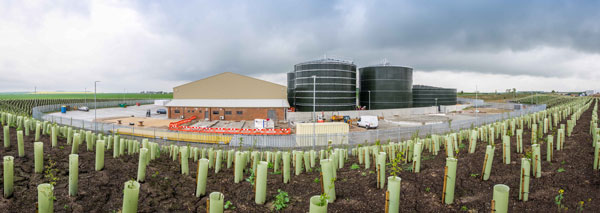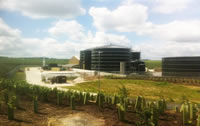Bygrave Lodge anaerobic digestion plant, nr Baldock, HertfordshireWhole Project Award |
|
Project Team
Client: Biogen
Designer: Rolton Group
Construction: Toureen Group
-------------------------------------------------------------------------------------------------------------------------------------------------------------------------------------
Project summary
The £12m anaerobic digestion (AD) plant at Bygrave Lodge Farm, near Baldock in Hertfordshire was developed as part of Biogen’s strategy to build a network of green energy plants across the UK. The AD plant will provide a sustainable food waste treatment solution for homes and businesses in Hertfordshire and the surrounding areas.

Due for completion in November 2014, the facility will process 45,000 tonnes per year of food waste from retailers, manufacturers and households to produce 2.2 MW of renewable electricity for up to 3,600 homes and a nutrient rich biofertiliser for nearby farmland.
Bygrave Lodge is Biogen’s first AD plant to undergo CEEQUAL assessment and a first also for construction partners Toureen Group and designers for the project, Rolton Group.
More significantly for the industry, this is the first ever sustainability in civil engineering award for a food waste AD plant in the UK.
Challenges and achievements
The anaerobic digestion of waste is in itself a very sustainable process, but constructing such a plant in a greenbelt area presents many challenges, not least limiting the impact on the local environment.
Protecting and preserving the natural landscape was given priority consideration during the planning and construction phases of the project. In addition opportunities were sought to enrich the landscape and enhance the area wherever possible.

Large Balancing Pond Planting Underway Panorama 9th October 2013
Planning regulations recommended the planting of several different species of trees [see appendix] to screen the AD plant, but the quantity was not specified. Long before the site was completed 14,000 trees were planted, forming a screen and also enhancing the future landscape. The tree species chosen and planted will be good food and habitat providers for birdlife once mature.
Other activities undertaken to improve the ecology and diversity:
- A screening bund was created using surplus materials from the construction site thus ensuring zero waste sent to landfill.
- A balancing pond [flood basin] developed on site was adapted in order to provide pond habitat for amphibians and other wildlife.
- Bunds were adapted to form beetle banks which will create a suitable habitat for invertebrates.
- Perching posts for corn buntings, a species which has been in decline, have been installed to encourage their return to the area.
- LED lighting was installed internally and externally providing low power consumption, low maintenance and less light pollution overall.
- Rainwater harvesting was implemented to reduce potable water usage . All water on paved areas is captured and sent to the balancing pond also for re-use on site.
Selected UK Native Trees and Shrubs | Selected UK Native Aquatic and Marginal Plant Species
Common Name |
Scientific Name |
Common Name |
Scientific Name |
||
Trees: Aspen Beech Downy Birch Silver Birch Sessile Oak |
Trees: Populus tremula Fagus sylvatica Betula pubescens Betula pendula Quercus petraea |
Submerged Plants: Curled Pondweed Hornwort Water Starwort Callitriche spp. Floating Plants: Broad-leaved Pondweed Fringed Waterlily Frogbit Hydrocharis |
Submerged Plants: Potamogeton crispus Ceratophyllum dersum Callitriche spp Floating Plants: Potamogetan natans Nymphoides peltata Hydrocharis morsus-ranae |
||
Shrubs: Blackthorn Hazel Hawthorn Privet |
Shrubs: Prunus spinosa Corylus avellana Crataegus monogyna Ligustrum vulgare |
Marginal Plants: Watermint Waterforget-me-not Water Avens Marsh marigold Flowering Rush Sweet Flag Flag Iris |
Marginal Plants: Mentha aquatica Myosotis scorpioides Geum rivale Caltha palustris Butomus umbellatus Acorus calamus Iris pseudacorus |
To what extent did the use of CEEQUAL influence your project?
 Bygrave Lodge Exterior |
The CEEQUAL assessment recognises and rewards best practice which is invaluable to a relatively new industry such as anaerobic digestion. Undertaking the assessment has helped Biogen develop a greater awareness of approaches to sustainability and provided standards and guidelines which can be implemented in future projects. The assessment has helped shape the decision making process when considering the whole lifecycle of the Bygrave project and it is expected this will bring environmental benefits and cost savings to future developments. The majority of the Bygrave site was initially considered to be of relatively low ecological value but as a result of the actions undertaken during planning and construction, Biogen, in keeping with its values, has succeeded in not only protecting the environment but also improving and enhancing it thus assisting ecological diversity of the local area. |

